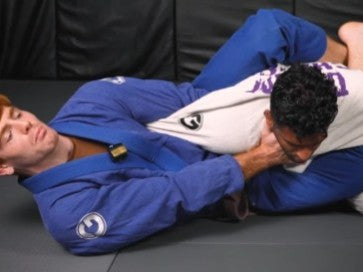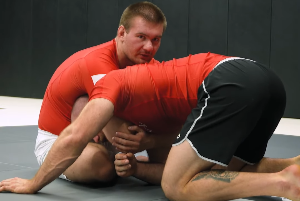
Brazilian jiu jitsu (BJJ) is a grappling-based martial art that has its roots in self-defense. Unlike other martial arts like muay thai, karate, and taekwondo that incorporate striking and kicking, BJJ focuses on ground fighting, controlling your opponent, and submissions through chokes or joint locks.
Although interest in BJJ in the United States has grown in large part due to the popularity of mixed martial arts (MMA) and the Ultimate Fighting Championship (UFC), jiu jitsu has a long, rich history that stretches back to feudal Japan. Many historians believe that early jiu jitsu techniques of takedowns or throws, joint manipulation, and chokes were used by samurai as a means to defend themselves against armed opponents if they found themselves unarmed and on foot.
The name itself comes from the Japanese words “Jū,” which can be translated as “gentle, flexible, or yielding,” and “jutsu,” which generally means “art” or “technique.” Modern BJJ may not look like a particularly “gentle art” to outside observers, but because practitioners depend on leverage, pressure, angles, timing, and joint manipulation, as opposed to punches, kicks, and elbows to outmaneuver their opponents, the name still fits.
History of BJJ
So how did jiu jitsu get from samurai in Japan to the UFC in the United States? It went through Brazil. Mitsuyo Maeda, a renowned martial artist who combined traditional Japanese jiu jitsu techniques with judo and competed in no-holds barred competitions, brought his style of fighting to Brazil in 1914. Three years later, he accepted Carlos Gracie as a student. Together with his brother Hélio, Carlos Gracie then further adapted the techniques he learned into what we now know as BJJ.
By the 1960s, the Gracie style of jiu jitsu had established a firm foothold in Brazil, with many of the Gracie family members and students demonstrating its effectiveness in Vale Tudo (“everything goes”) matches against other martial arts styles of fighting.
Although Rorion Gracie brought BJJ to California in the 1970s, most of the United States remained unfamiliar with the sport until the 1990s when Rorion and Art Davie, an American entrepreneur, put on the first UFC tournament on November 12, 1993. UFC 1 pitted several martial arts styles (savate, karate, sumo, kickboxing, tae kwon do, shootfighting, and BJJ) against each other to determine which was the best.
In order to emphasize the effectiveness of BJJ, Rorion chose his brother Royce as the Gracie representative, since most of his opponents would be much larger. Royce’s three impressive submission wins allowed him to become the first UFC champion and helped introduce a wider American audience to BJJ. The success of that and subsequent UFC events, along with the rise of MMA, have played a huge part in the growth of BJJ in the United States.
Fundamental Techniques
One of the reasons that so many people are drawn to BJJ is that there are endless variations of techniques and sequences you can study and practice to get the better of your opponent, so you will never get bored. Not only is BJJ physically challenging, but it’s also mentally engaging at the same time. In fact, it’s often compared to human chess where you’re constantly strategizing and problem-solving, based on your opponent’s moves.
But everyone has to start somewhere. Before you go down the rabbit hole of studying more complicated moves like anaconda chokes and berimbolos, it’s helpful to concentrate on some of the most fundamental techniques you are likely to learn when first starting to train BJJ: arm bar, triangle, and rear naked choke.
Arm Bar
An arm bar is one of the simplest and most effective techniques in BJJ and can be accomplished from many different starting positions. The basic arm bar involves trapping your opponent’s arm between your legs to control and hyperextend the elbow. Because you are basically using your whole body against your opponent’s arm, this is an excellent self-defense technique for a smaller person against a larger opponent.
Triangle
Another fundamental technique that most beginners learn early in their jiu jitsu journey is the triangle. As the name suggests, your legs form a triangle, or figure four, when you lock your knee over your ankle around your opponent’s neck and one arm. As you squeeze, your legs put pressure on the neck, resulting in a choke.
Rear Naked Choke
The choke that most people are familiar with, especially if they watch MMA, is the rear naked choke. Starting from back control with both of your legs hooked around your opponent’s legs, you slide one arm in front of their neck and grab either the back of their shoulder or your own shoulder or bicep. From there, you can push their head forward with your free hand or your head to put more pressure on their neck, compressing their arteries, which restricts blood flow until they submit.
Belt System
As with many other martial arts, BJJ uses a system of colored belts to track progress. Practitioners work their way through white, blue, purple, brown, and black belts, usually earning four stripes per belt at regular intervals (depending on consistency of training, progression in skill, previous experience in other grappling sports or martial arts, etc.). Every school is different with how often they promote, whether they have students test for a belt, whether they have certain attendance requirements, etc., but most BJJ schools follow the general guidelines set by the International Brazilian Jiu Jitsu Federation (IBJJF) for the minimum amount of time that must be spent at each belt. In general, it takes at least 10 years of consistent training to go from white belt to black belt.
Gi vs Nogi

Traditionally, people training BJJ wear a gi, which is similar to the uniform worn in other martial arts like karate and judo. The type of BJJ in modern MMA is what is known as “nogi” where practitioners wear a rashguard (either long- or short-sleeved) and shorts (sometimes with leggings underneath).
The main difference between the two is grips. In gi, you have plenty of material to work with to control your partner - grabbing anywhere on the sleeves, pants, and lapels. Many chokes involve using the collar as another point of pressure on your opponent’s neck, and you can often tie up and control your opponent using their own gi or yours. Some practitioners feel that gi is more technical than nogi.
In nogi, you are not allowed to grab material. Instead, grips focus on controlling the wrists, ankles, shoulders, knees, and neck. Nogi tends to be faster and relies on more explosive movements similar to wrestling.
Many BJJ practitioners prefer one over the other, depending on their personal style of jiu jitsu, but most agree that it’s helpful to train both.
Competition
As interest in BJJ has grown over the years, so has the competition scene in both gi and nogi. The IBJJF, American Grappling Federation, North American Grappling Association, and Jiu Jitsu World League are some of the larger organizations that regularly hold sport jiu jitsu competitions across the United States for both adults and kids. But there are many other organizations and competitions out there if you want to test your jiu jitsu against others.

When you sign up for a competition, you will be matched with other competitors based on age, weight, and belt level. If there is no one in your bracket, you may be asked to move up in weight class or down in age.
Competitors are assigned a time and mat number and are usually required to weigh in at least an hour before the match (with the gi on, if it’s a gi competition).
During the match, a referee awards points for various techniques and positional control, including takedown (2 points); guard pass (3 points); knee on belly (2 points); mount (4 points); sweeps (2 points); and back control (4 points). Competitors must control the position for a count of three seconds to be awarded the points. In these traditional types of competitions, you win either by scoring more points than your opponent or submitting your opponent.
Although less common, there are also submission-only jiu jitsu competitions for both gi and nogi where the focus is on submissions rather than positional control. While these types of competitions can be very exciting to watch, they can also make it more difficult to determine a winner if there is no submission within the allotted time.
How to Get Started in BJJ
So, are you ready to step on the mats and start your own BJJ journey? The first step is to find a gym. Some key things to consider when looking for a gym:
- Location: If the gym is close to your work or home, you are much more likely to train consistently.
- Culture: If you are a serious athlete looking to compete, you might choose a gym that is more competitive and emphasizes submissions. If you are a hobbyist, you might look for a gym that's a little more relaxed and family friendly.
- Cleanliness: BJJ is a full contact sport. Dirty mats and bathrooms = athlete's foot, ringworm, and worse.
- Training partners: One of the best parts about training jiu jitsu is the community. Look for training partners who are friendly and who will help you work towards your goals as opposed to going 100 percent in every roll without worrying about injuring you.
- Gi and Nogi: Even if you're only primarily interested in one or the other, try to find a gym that offers both gi and nogi. Training in both will have surprising benefits to your game, especially when it comes to learning to control your partner. Also, nogi is more realistic in a self-defense scenario.
Most gyms offer at least one trial class. Take full advantage of this option and maybe check out a few different gyms in the area before committing to one. It’s also a good idea to stay and watch sparring sessions (sometimes called “rolling” or “live training”) to get a better feel for the gym’s culture, training partners, and overall environment.
What Gear Do You Need?
If you’re planning to attend a trial class, most schools will have a gi you can borrow, or, if it’s a nogi class, you just need a rashguard and shorts. Once you’ve committed to a gym, they might have a specific gi, rashguard, and shorts they want you to buy, or you might be able to buy your own gi and just add a patch with the gym’s name, or they might not have any restrictions at all.
The gym should provide you with a white belt to start, but you’re also welcome to buy your own belts as you go through the system. Some practitioners like to have separate belts for competitions or special occasions like seminars or belt promotions.
Other helpful gear includes finger tape, which can provide extra support to your fingers (they will get sore from grips) and toes; a good jiu jitsu bag specifically made to hold a gi; a mouthguard; and headgear, if you’re worried about developing cauliflower ear.
What to Expect at Your First Class
Nerves. Everyone is nervous on their first day. Just remember that every single person on the mat with you started as a white belt who didn’t know how to close their guard. Commit to showing up and working hard. Try not to compare yourself to others. And, most importantly, have fun, and enjoy the journey.



